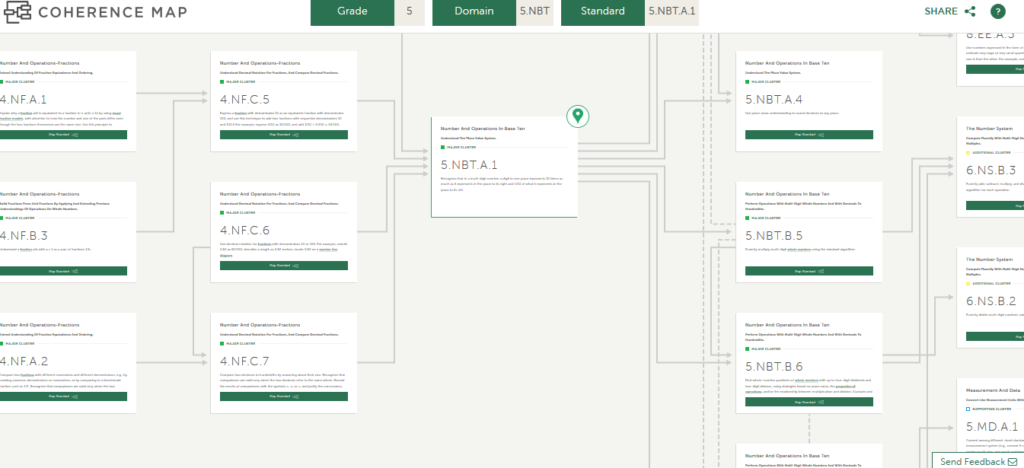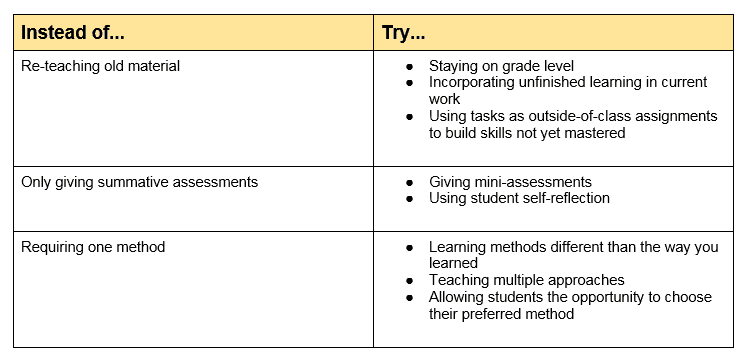One of the best things about being an educator is that you never stop learning. Even after twelve years in the classroom teaching the same classes each year, I still find myself learning: new concepts, new ways to teach old concepts, new methods of teaching, etc. Here are just a few of the things that I have learned over the past several years that you might be able to try in your own classrooms!
Always teach on grade level
Instead of spending time teaching unfinished learning that is not on grade level, try incorporating math concepts that are necessary in the moment as a “sidebar” with students. Just because a student is not on grade level for a particular topic does not mean that they cannot access grade-level content. For example, a student in high school who is weak in integer operations can still master solving systems of equations and should not be kept from this grade-level content because they did not master integers. The Coherence Map is a great resource for determining what your students should know, identifying potential weaknesses in their prior knowledge, and providing tasks for them to master previous standards while staying on grade level.
Give multiple mini-assessments
Instead of waiting until the end of a unit to assess students, try giving mini-assessments to check for understanding throughout the unit. There are multiple options for quick and easy assessments to see where your students are. One of my favorite student self-assessments is the “fist-to-five” routine. In order to see if a student feels ready to practice on their own or needs another example, students hold up anything from a fist-to-five with a fist being totally lost and five being ready to move on. This provides students an opportunity for self-reflection and allows you to adapt your lesson based off of immediate student feedback. Mini-assessments allow for a quick check for both the student and the teacher to know if material should be reviewed before moving on. Check out this example of a fourth grade fractions mini-assessment on achievethecore.org.
By using these two questions, a teacher can quickly see where a student stands on equivalent fractions. Each question provides a different aspect of equivalent fractions that would show a teacher what specific aspect students might not have mastered.
Learn (and accept) multiple methods of solving a problem
Instead of teaching only one method for solving a problem, allow students a choice of multiple options to complete the same problem. The ultimate goal in a math classroom is for students to become mathematical thinkers, not replicators of their teacher. Solving equations is a perfect illustration where one method can hinder students’ ability when equations become more complex. For example, in problem 5 (from the Achieve the Core eighth grade mini-assessment on solving equations), one student might choose to distribute the 8 first while another student might choose to divide both sides by 8. Since these are both mathematically correct, teachers should not force students to solve the equation in only one way.
While there are more efficient ways to work with most mathematical concepts, students should be allowed to use whatever method they are comfortable with as long as it is mathematically sound. If students are flexible mathematical thinkers, they will be more capable of applying concepts to any challenge they may face later.
Work Collaboratively
Instead of being an isolated island in your own class, work together with other teachers in your same grade or subject level. As experts in the educational field continue to research and discover best practices, they are realizing that collaboration with others is the best practice to ensure student success. As teachers work together, lessons and assessments become more aligned and engaging for students. The more students are engaged and discussing mathematics, the more they are learning.





















I do believe in staying on grade level as being the most important Best Practice.